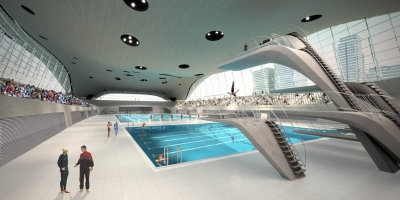
Outer space: When errors snowball
Errors cause problems. But errors are not necessarily mistakes. They are uncertainties in our knowledge of the true state of affairs. Sometimes these are one-offs: we want to measure a baby's weight and our digital scales are only accurate to a gram, so we have an unavoidable "error" of one gram in our determination of the baby's weight. Sometimes errors can be dramatically cumulative, and double (or worse) at each stage in a many-step process: this is the source of the phenomenon of chaos that has been so well publicised over the past thirty years. It bedevils our attempts to predict the weather with great accuracy. In between these two extremes there is another type of error that stays the same at each stage in a many-step process, but accumulates in ways that can lead to a significant overall uncertainty.

Athletics track: accuracy matters
If you are building a swimming pool or a running track that is going to be used for races and time trials covering many laps, then the accuracy of the lap length is very important. Make the track or pool too short and the distance covered will fall short of the required distance more and more as the race progresses. Any records set will be invalid when ultimately checked by laser ranging. A running track can make adjustments to its finish line to counter final construction errors, but a swimming pool doesn't have that option.
Suppose a race has length $R$ and covers $N$ laps of length $L$, so $NL = R$. If the construction of the stadium has led to an error in the length of a lap equal to $\epsilon$, then the cumulative error over the race will be a distance $N\epsilon = \epsilon R/L$. In practice, it is timing that we are interested in for record purposes. If the time to complete the race is $T$, then the average speed is $R/T$ and the overall time error, $\Delta T$, introduced by the error in the length of the lap is $\Delta T = (R/L \times \epsilon )/(R/T) = T \epsilon /L,$ so we have the very simple result: $$\Delta T/T = \epsilon/ L.$$This tells us that the fractional error in the total race time is equal to the fractional error in the lap length.
In the construction of international athletics tracks the IAAF tolerance standard is that a 400 metre lap determined by an average of measures of its straights and bends is allowed to be up to 4 cm over length but not under length. For FINA approved swimming pools, a 50 metre pool can be built up to 3 cm over length, but again there is no tolerance for it to be under length. This is to ensure records can't be broken by under length races (or, worse still, that all times recorded on a short track or in a short pool are invalid for any statistical or comparative ranking purposes).
| Lap length L | Max allowed lap length error | Overall race time error in seconds if race lasts T seconds | Duration of race with > 0.01 sec error | |
| Athletics track | 400m | 0.04m | 10-4 × (T/1sec) | 100 sec |
| Long-course swimming | 50m | 0.03m | 6 × 10-4× (T/1sec) | 16.7 sec |
| Short-course swimming | 25m | 0.03m | 12 × 10-4 × (T/1sec) | 8.3 sec |
In the table above we have worked out the consequences of this formula if the maximum tolerance is used, and the running track is 4 cm over length and the swimming pool is 3 cm over length. In the last column we work out the amount of time the race would have to go on for in order for the lap length error to produce an overall timing error exceeding 0.01 sec, which is the accuracy of time keeping for records in athletics and swimming.

Precision is crucial. Computer model of the London 2012 Aquatics Centre. Image courtesy London 2012.
All swimming races exceeding 50m are affected and all standard track events of 800m and longer. For a 10,000 metre race at world record pace for men (26 mins 30 sec), the cumulative error would be 0.16 secs, quite significant. Of course, the situation in running events is less clear-cut because competitors can choose to run difference total distances by running wide of the inside lane kerb for tactical reasons, and almost everyone runs over distance. In swimming the situation is more clear-cut. Careful surveying really counts.
Comments
Anonymous
The (new) adage: to pay attention to initial conditions
can only take one so far in our error-prone world.
Clearly, iteration whether at a desk or easel or even computer
contributes to uncounted propagation-errors.
Me? I observe everything I can in the mornings, and less so
in the evening when things are just running their course.
Do you think we'll be able to 'harness chaos theory in the near future?
Anonymous
While swimming pools in the higher latitudes are heated to a constant temperature which does not vary much, one wonders at what time of day the lengths are measured in pools in hot climates. Can the physical expansion of the pool be significant? Or does the cooling effect of the water evaporting take care of this? Expansion certainly has to be taken into account in relatively short lengths of other civil engineering structures such as bridges.
Since the actual lengths of swimming pools can be measured much more accurately than three centimetres, could not the appropriate body produce a correction factor for times in each pool so that records could be compared directly?